#American Stuntmen
Photo
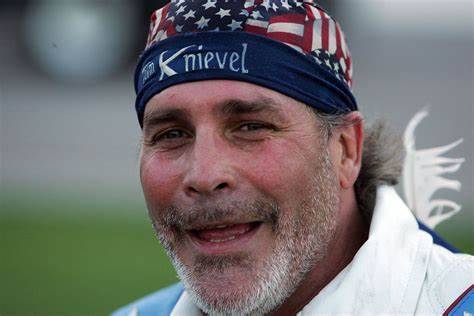


ROBBIE KNIEVEL (1962-Died January 13th 2023,at 60.Cancer). American daredevil and son of stunt performer Evel Knievel.He had also used the code name "Kaptain Robbie Knievel".Robbie Knievel was the son of the stuntman Robert "Evel" Knievel and his first wife, Linda. Knievel had several jumps televised live, including the Caesars Palace jump, the building-to-building jump in Las Vegas, a jump over a moving train, a jump in front of the volcano at the Mirage Hotel in Las Vegas, Nevada and the Grand Canyon jump. https://en.wikipedia.org/wiki/Robbie_Knievel
#Robbie Knievel#American Stuntmen#Stuntmen#American Stunt Performers#Stunt Performers#Evel Knievel#American Daredevils#Daredevils#Notable Deaths in 2023#Notable Deaths in January 2023
7 notes
·
View notes
Text

Denise Masino w/Hollywood Yates
11 notes
·
View notes
Text

Too loud, too bright, too sexual… Mexico's Lupe Vélez was utterly broken by scandal-hungry 1940s Hollywood – even after her death.
The wild saga of Lupe Vélez, Hollywood's first tabloid casualty

On the evening of December 13, 1944, 36-year-old Mexican film star Lupe Vélez was found by her personal secretary, laid out on her bed in California like a painted doll and wearing blue satin pyjamas, surrounded by fresh flowers and burning candles.
She was dead, having intentionally overdosed on 75 Seconal pills (a barbiturate) with a glass of brandy after dinner. She was also pregnant, no doubt suffered from bipolar, and left behind a life papered in tabloid headlines and scandal.
Yet, what should have been an international tragedy – a wake-up call to the media around the fragility of celebrity and mental health – was soon turned into farce by underground filmmaker Kenneth Anger. He published Hollywood Babylon, a widely-sold compendium of Tinseltown’s juiciest rumours.
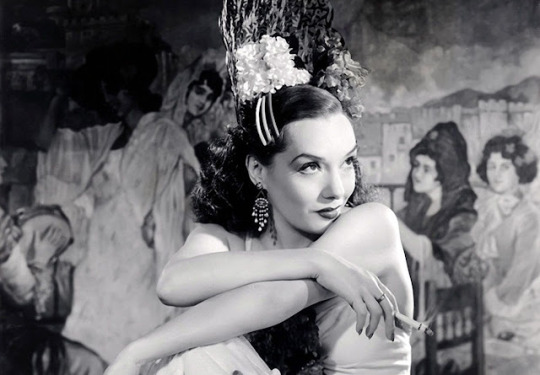
“Her ethnicity was played up for her films, and, for the sake of her 'public image' she fell into that characterization, both on and off screen,” writes Vélez biographer Michelle Vogel in her book Lupe Vélez: The Life and Career of Hollywood’s Mexican Spitfire.
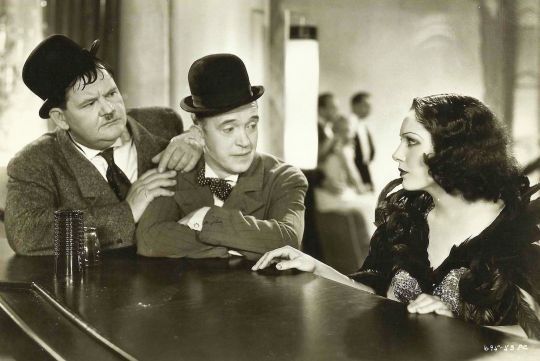
Oliver Hardy, Stan Laurel and Lupe Velez, in the 1930s

Lupe Velez and Douglas Fairbanks in O Gaucho

Violent love: Lupe Vélez and Gary Cooper in 1929
Vélez exercarbated the intrigue in her interviews, chillingly telling one fanzine, “I think I will kill my Gary, because he does not get angry when Lupe is angry with him.” Eventually Cooper left her, and was ordered by Paramount Studios to take a holiday on account of his nervous exhaustion and 45-pound weight loss considered a result of his relationship. The day he boarded the train to get away, Vélez ran onto the platform, smashed the glass of his window pane and tried to shoot him with her pistol while reportedly shouting, “Gary! You son of a bitch!”

A brief marriage to Tarzan star Johnny Weissmuller followed suit in October 1933, and the bruises and love bites they both sported as a result of their “passionate lovemaking” were regularly noted in the press (and commented on by makeup artists on the Tarzan films, whose task it was to cover Weissmuller’s up).
“Another misconception is that she was a loose woman…” said Vogel. (In Hollywood Babylon Kenneth Anger described her “going through a small army of lover – cowboys, stuntmen, and American gigolos.”) “Sure, she loved to party and have a good time, but she was fiercely loyal to her men. She was committed to Gary Cooper and Johnny Weissmuller for almost 10 years of her life. She helped everyone and supported her extended family in Mexico for much of her life,” continued Vogel. Indeed, it was reported that Vélez kept her personal phone number listed so that fans could call her up and chat when they were in distress. She also had a big heart, keeping a large menagerie of rescue animals which included horses, monkeys, canaries, turtles and dogs.
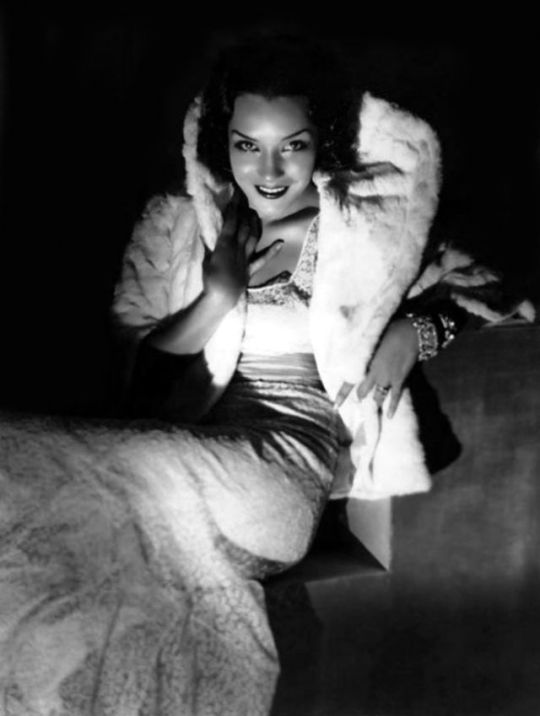
“Although the public thinks that I'm a very wild girl. Actually I'm not. I'm just me, Lupe Vélez, simple and natural Lupe. If I'm happy, I dance and sing and acted like a child. And if something irritates me, I cry and sob. Someone called that 'personality'. The Personality is nothing more than behave with others as you really are. If I tried to look and act like Norma Talmadge, the great dramatic actress, or like Corinne Griffith, the aristocrat of the movies, or like Mary Pickford, the sweet and gentle Mary, I would be nothing more than an imitation. I just want to be myself: Lupe Vélez .”
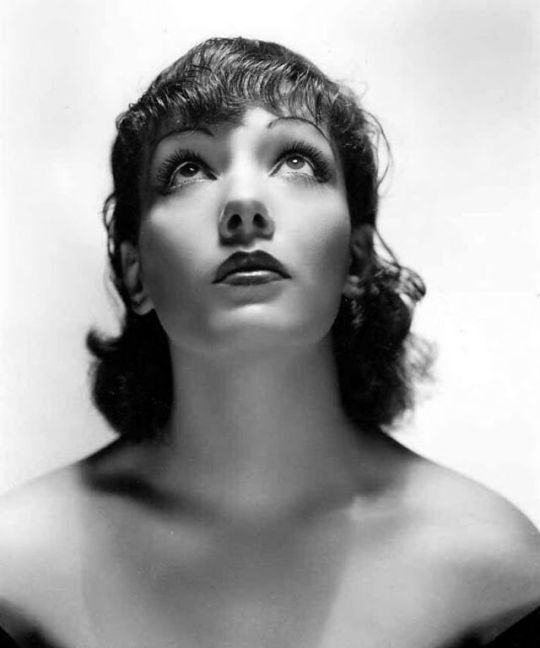
#photography#lupe vélez#gary cooper#Johnny Weissmuller#old hollywood#douglas fairbanks#vintage photography#cliff clavin
86 notes
·
View notes
Text
Alright we're gonna talk about BATTLE DOME
You asked for off-topic content, so we're gonna talk about one of my obsessions from the past year: BATTLE DOME.
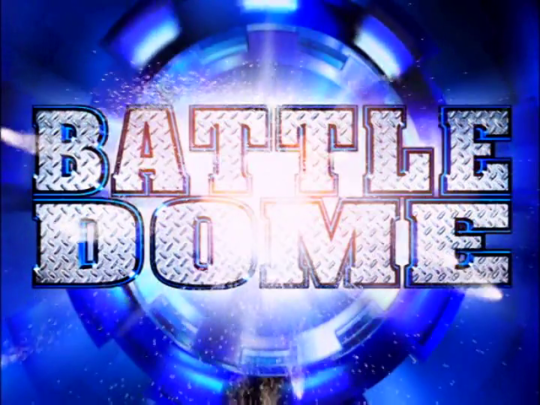
I know there's a lot of Y2K-era nostalgia now, but if you lived through the Bush years, you probably remember that the early 2000s were a cultural wasteland of amped-up, testosterone-addled, hyper-sexualized garbage.
At the top of that pile was BATTLE DOME, a short-lived TV game show that aired for two years in syndication, presumably to low viewership. BATTLE DOME attempted to blend the over-the-top athletic competition of American Gladiators with the hypermasculine, character-driven soap opera of professional wrestling.
The result was maybe the stupidest show ever to air on television: an extraordinarily dangerous game show where competitors regularly walked away with serious injuries, interrupted by scripted melodrama that played like it was written by and for horny middle schoolers. It is spectacular, and it's almost too unintelligible to be offensive.
The pitch for Battle Dome is simple: three random competitors compete in a series of demanding physical events against THE WARRIORS, an ensemble cast of underemployed Los Angeles-based bodybuilders, stuntmen, and MMA fighters, who have come together here to play a collection of cultural stereotypes and beat the absolute shit out of the hapless contestants.

Here's one of the warriors, Mike O'Dell, a grotesquely muscular dude presented as a white-clad golden god with uncomfortable Aryan overtones. He's at least a head taller than all the contestants and could probably eat them.

There's also T-Money, played BY A YOUNG PRE-FAME TERRY CREWS IN HIS FIRST ACTING ROLE. Getting him on this show was an incredible casting coup in hindsight.
Every event on Battle Dome has a simple objective, like knocking your opponent off the monkey bars. Except this is Battle Dome, so the monkey bars are 15 feet off the ground. And the bars are shaking. And there's a massive man kicking you in the chest.

They call it Aerial Kickboxing.
But the real highlight of Battle Dome are the terrible wrestling plotlines they interject between (or sometimes even during) the events. They're usually arbitrary, poorly written, and just an excuse to make the beefy men fight each other. In this episode, T-Money is pissed at O'Dell because he's underperforming.
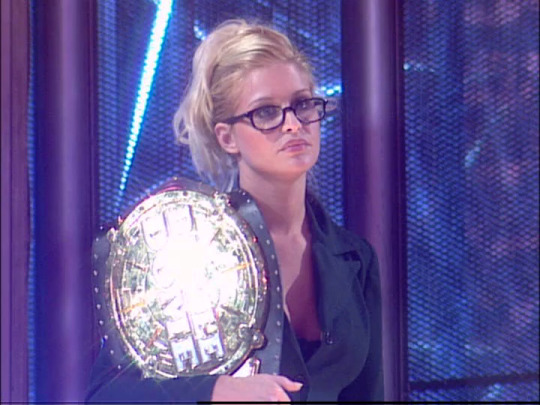
After an episode's worth of O'Dell and T-Money throwing barbs at each other, they finally must come to blows. Bobbie Haven, the "sexretary" to the Battle Dome Chairman, demands that the warriors must compete in ULTIMATE BODY SLAM to decide who is the number one warrior!
What is ULTIMATE BODY SLAM, you ask?



I've never been into pro wrestling, but I get the sense that part of the fun of pro wrestling is being a "mark," suspending your disbelief and buying into the fake reality. I do not know how you can do that for Battle Dome. The problem is that the Battle Dome warriors are competing against real humans, which makes their fake absurd antics even faker and more absurd. There is no kayfabe. There is no hermetically sealed world of Battle Dome fiction. This is more like Legends of the Hidden Temple with punching.
But you know what's definitely not fake on Battle Dome? The violence. This show is brutal. Concussions are received. Bones are broken. Even the actors aren't immune to injury. Terry Crews said years later that he almost got set on fire once during an event.
The tagline for the show was "Real Warriors, Real Pain," and at least the second one of those is correct. Pain is the only real thing in the bizarre world of Battle Dome, where emotional truths have been replaced by body slams.
This is clearly not a good television show, and it is incredibly fun. 20+ years removed from airing, it's much easier to laugh at. If I wanted to show someone what American culture felt like at the turn of the millennium, I would show them Battle Dome. I would show them its bacchanalia of testosterone, its bizarre miscalculation of human drama, its Tommy Wiseau-style acting and understanding of women, its unrelenting grinder of human bodies, and then I would get popcorn.
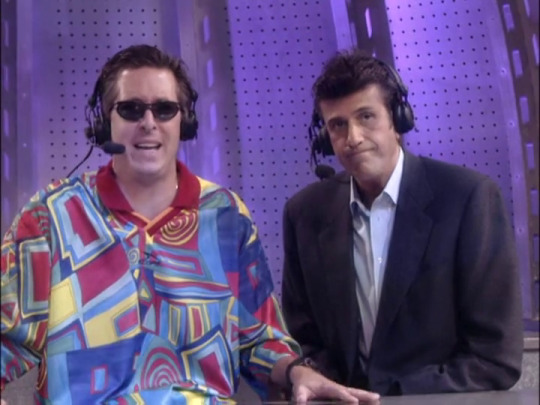
PS: Here are the two announcers for Battle Dome: Steve Albert (right), professional sportscaster; and Scott Ferrall (left), shock jock and professional feral man, dressed like he's about to go on a cruise inside a surrealist painting. Albert does the play-by-plays, while Ferrall screams incoherent horny color commentary in a gravely voice that sounds like he's been smoking six packs of cigarettes a day since kindergarten. They are truly a dynamic duo.
75 notes
·
View notes
Text
In keeping with my plan to watch more of Gen Urobuchi's shows (by which I mean anything he wrote at least two-thirds of the episodes for, instead of consulting), I started Kamen Rider Gaim and have watched the first two episodes. Thoughts:
I don't have much experience with tokusatsu as a genre, outside of watching the first half of Kamen Rider Den-O, some cultural osmosis about Power Rangers (the American version of the Super Sentai franchise), and parodies like Special Combat Unit Shinesman. Still, it was striking how many of the tropes were familiar, to the point where it feels like Kamen Rider Gaim is a magical girl show starring a grown man.
And the reason for this is that the magical girl genre was heavily influenced by tokusatsu in the '90s--Sailor Moon drew heavily on the genre's tropes, giving what had previously been a masculine genre a feminine approach. A team of color-coded warriors in matching outfits showing up to battle outrageous cartoon monsters and save the day by striking power poses and calling out their attacks? Yeah, that's tokusatsu in a nutshell. Prior to Sailor Moon, magical girls tended to work solo and transform into cute witches and pop idols instead, but the new vision was so popular that it eclipsed all that in the popular imagination, to the point that it's what first comes to mind when most people think about mahou shoujo as a genre.
Anyway, people made a lot of fuss about the Urobutcher writing for Kamen Rider when he was best known for dark magical girl anime, but to me, it's not that much of a stretch. The toys and the aesthetic are different--more sci-fi/mecha than frills and sparkles, and stuntmen wailing on each other with plastic swords and transparent special effects rather than animation, but the core is remarkably consistent across seemingly disparate genres.
The real way you can tell Urubuchi wrote this particular story is 1) DJ Exposition is very clearly an authorial favorite, and b) at least one of the swords doubles as a gun.
3 notes
·
View notes
Text

Joseph Frank "Buster" Keaton (October 4, 1895 – February 1, 1966) was an American actor, comedian, and filmmaker. My grandma met him, at a personal appearance at Disneyland, in 1957. She got his autograph, and handed it down to me, in the 1980s. I had it framed.
Remembering him, on the anniversary of his birth. A comedy legend and pioneer. He was trained as a small child, with the family act, in vaudeville. He did all of his own stunts and could still do a lot of tumbling and pratfalls, well into his elder years. He learned how to do it, without getting hurt. One of Hollywood’s early stuntmen, Buster was strong, physically fit, a hardcore athlete, for a small-framed man, who was only 5’5’’ and 150 lbs.
He overcame alcoholism, in the 1940s, which had contributed to his downfall, in the early 1930s. He struggled to get by, for many years. He was hired as a comedy writer and consultant, for many film comedies, with a few appearances, onscreen.
Then, He had a bit of a career revival, in the 1950s, and 60s. He would take any and all jobs, that had a paycheck. He was in many TV commercials and print ads, in the 1950s and 60s. He appeared on TV, a lot and made several appearances in the Beach party films, with Frankie and Annette, in the 1960s. His Twilight Zone episode is a classic. Even though he had recovered from his alcoholism, he still took jobs advertising alcoholic beverages, but he didn't drink them.
He literally had to work until he died, as he had lost his multi-million-dollar fortune to his wife, in a particularly bad divorce, in 1932. His ex-wife took all of the money and property. He ended up having little contact with his children.
One of his greatest late-career appearances is in A FUNNY THING HAPPENED ON THE WAY TO THE FORUM, in 1966. It was one of his last film appearances. He had cancer, but he had no idea how ill he really was, in the end. Cigarettes had taken their toll.
View insights
4 post reach
Like
Comment
Send
9 notes
·
View notes
Text
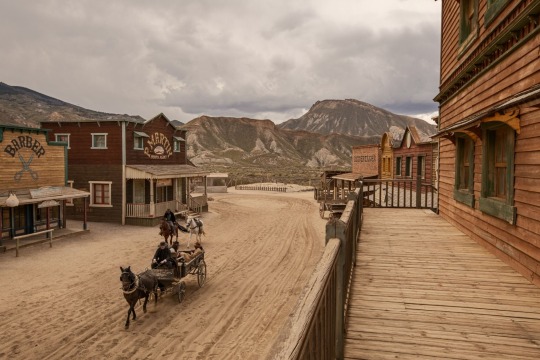
Stuntmen ride horses and drive carriages at Oasys MiniHollywood, one of several Western film sets in Spain’s Almería region. The area’s deserts and canyons have attracted movie and TV crews since the 1950s. Today, their faux Old West towns are also open for cowboy shows and tours. Photograph By Matilde Gattoni
The Wild West Lives on in Southern Spain
This desert region plays a major role in Western movies—and offers travelers cinematic scenery and cowboy culture.
— B y Matteo Fagotto | Photographs By Matilde Gattoni | January 19, 2022
The worn wooden floorboards squeak under Rafael Molina’s heavy steps as he paces the saloon. Outside, the sound of galloping horses breaks the silence of the surrounding desert. All around him, the Old West town’s empty shops and abandoned houses look as if they have just been ransacked by cowboy bandits.
“When I was a kid, I could only dream about all this,” says the 68-year-old former actor and stuntman. “My aspiration was to see a film set firsthand. Today I own one of the most famous ones in the history of Western movies.”

The Oasys MiniHollywood movie set is located amid the Sierra foothills in Spain’s Tabernas Desert
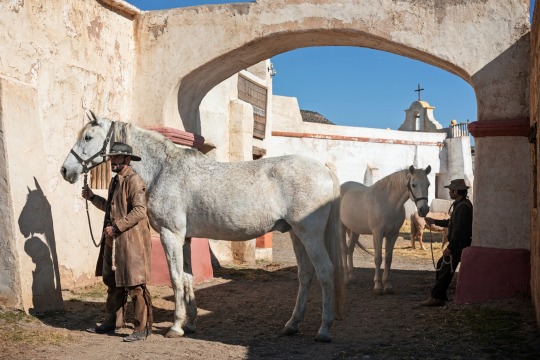
Professional stuntmen Ricardo Cruz Fernández (left) and Rafael Aparicio García (right) work as film extras and cowboy show performers at Fort Bravo in Tabernas, Spain.
Molina bought the set, called Fort Bravo, at the end of the 1970s. But this busy movie site is located in Spain—not Montana or Texas. It’s one of three faux Old Western towns in the small village of Tabernas and the surrounding desert of the Almería province. Since the late 1950s, these rugged mountains, arid plains, and dry canyons have provided the backdrops for more than 170 movie Westerns, including The Good, the Bad and the Ugly (1966) and Once Upon a Time in The West (1968).
Other movies and TV series were filmed at Tabernas, including Indiana Jones and Game of Thrones. But this windswept region—a 30-minute drive north of the coastal city of Almería—remains synonymous with Western shootouts.

These days, it’s a lure not only for neo-Western film directors, but also for travelers wanting to sink their spurs into its lore and landscapes. Here’s the unlikely story of how so many movies set in a near-mythological region of the United States ended up being filmed in southern Spain. We also share how travelers can experience the cinematic landscapes and the fascinating people bringing the Old West to life.
A Community of Cowboys
Molina belongs to a small community of local cowboy actors and stuntmen in Tabernas who have played a role in movies and TV shows since the first productions in the 1950s. They can perform anything from fistfights to horse drags. Knowledge and skills often pass from father to son, keeping tricks of the trade in the family. Steeped in the golden era of Westerns, these actors embody the values of their movie heroes: pride, bravado, freedom, and a trusting relationship with horses.
“I’ve always liked horses and the [U.S.] West,” says 29-year-old Ricardo Cruz Fernández, a stuntman and cowboy who appeared in recent productions including Game of Thrones and The Sisters Brothers, a 2018 Franco-American Western starring Joaquin Phoenix. Fernández started his career as a cowboy after completing a stuntman course a decade ago.
Between productions, he performs daily shows at Fort Bravo for thousands of tourists who visit the set each year. In one show, Fernández portrays a bank robber who absconds with some gold. Visitors encounter him in the saloon, fist and (fake) gun fighting with actors playing his double-crossing accomplices. The town also offers cancan dance shows and set tours by horse-drawn wagon.
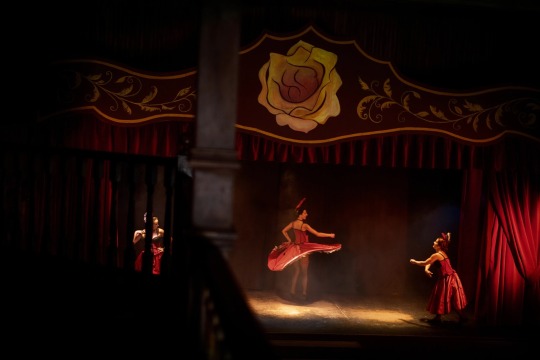

Left: Cancan dancers perform in the saloon at Oasys MiniHollywood in Tabernas, Spain. Right: A horsewoman trains a young Andalusian horse in the streets of Oasys MiniHollywood, a Western movie set in southern Spain.
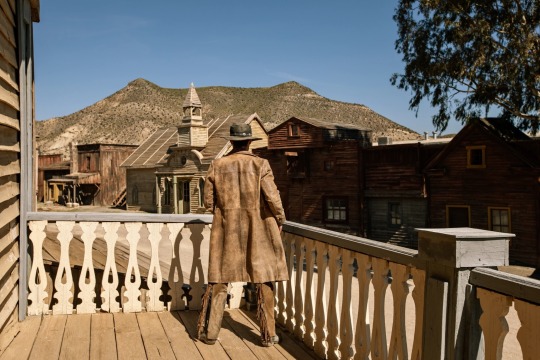
Stuntman Ricardo Cruz Fernández stands on the balcony of a building in Fort Bravo, one of three Western movie sets in Tabernas, Spain.
“I prefer to play the bad guy, because it gives me a wider range of possibilities,” says Fernández. “The good guy only has to keep things in order.”
His romance with the Wild West started when, as a kid, he saw Italian director Sergio Leone’s so-called “Dollars Trilogy.” The trio of films—A Fistful of Dollars; For a Few Dollars More; The Good, the Bad and the Ugly—were shot during the 1960s in the Almería region. They starred a young, still-unknown Clint Eastwood as a poncho-wearing cowboy with no name.
“Leone’s movies didn’t need much dialogue or intricate plots,” says Fernández. “The actors’ gestures, the music, and the little details are enough to give you goosebumps.” Leone’s innovative shooting style and captivating soundtracks in the Trilogy paved the way for the so-called “spaghetti Western,” a popular film genre in the 1960s and 1970s. Most of its directors were Italians, while producers and actors were a mix of Italians, Spaniards, and Americans, all speaking their own languages onscreen.
Snubbed by U.S. critics at first, spaghetti Westerns became hugely successful due to the disenchanted vision they brought to a film style that had almost disappeared. The Wild West figures they depicted were a far cry from the heroic white conquerors of earlier epics. Their main characters were not champions of the defenseless, but amoral bounty hunters moved by personal profit, greed, and vengeance. Actions and violence ruled; the good rarely triumphed.
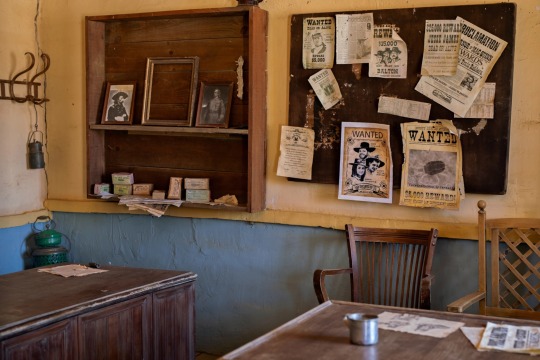
Old West-style “wanted” posters hang in the jail at the Oasys MiniHollywood film set.
Although Almería had already been used as a shooting venue for a few renowned movies (Lawrence of Arabia, Cleopatra), it was Leone, and the ensuing flurry of European Westerns, that finally brought the province’s stunning landscapes into the international spotlight.
Since then, Almería has hosted more than 500 productions, including blockbuster films (Patton, Terminator: Dark Fate) and TV shows (Doctor Who). “Our landscapes are very convenient. We have sea, desert, and snowy mountains all within a short distance,” says local producer Plácido Martínez. “We can serve as Texas, New Mexico, Arizona, California, and endless other natural settings.”
Horsemen Turned Stuntmen
When foreign Western productions discovered Almería in the 1960s, the province was one of the poorest in Spain, plagued by high unemployment and emigration. Despite its remoteness, production costs were extremely low and its inhabitants were skilled horsemen. They were ideal stuntmen and extras for spaghetti Westerns set on the border between the U.S. and Mexico.
“I was earning more money in one day than my father did in one week of hard labor in the gold mines,” says Manuel Hernández Montoya, a 61-year-old local who worked as an extra in several Westerns as a child. He now owns the cinema-themed hotel and restaurant Hostal Alba in the nearby village of Los Albaricoques, where the final duel of For a Few Dollars More was shot.

Left: Stuntman Rafael Aparicio García has been featured in several Western movies filmed at the Fort Bravo set. Right: Two stuntmen perform a shootout scene at Oasys MiniHollywood.
For a Fistful of Dollars was a huge success, spurring the construction of two open-air Western sets around Tabernas. (Called Oasys Mini-Hollywood and Western Leone, both are still used. When film crews aren’t around, they welcome tourists to their dusty streets and 19th century-style buildings with cowboy shows, tours, and horseback rides.)
The region had few paved roads at that time, and the cinema industry was instrumental in building Almería’s airport and first hotels. In just a few years, the town turned from a backwater into a sort of European Hollywood, with celebrities including Claudia Cardinale, the Beatles, and Charles Bronson sipping drinks by the Gran Hotel pool between scenes.
The movie industry also boosted the international image of Francisco Franco, the dictator who ruled Spain from 1939 to 1975. “The regime was very happy to welcome celebrities such as Ava Gardner, Frank Sinatra, or John Wayne,” says Evaristo Martínez, an Almería-based journalist and cinema expert. “Franco would facilitate international productions in any way, even those whose movies were censored locally.”
The spaghetti Western genre declined at the end of the 1970s due to a glut of productions, a sustained dip in quality, and the shifting interests of the public. A blow for the local cinema industry, this resulted in the loss of thousands of jobs and Western sets falling into disrepair. Abandoned by their owners, the sets were kept up by a few stuntmen offering tourist shows to make ends meet. When Molina bought Fort Bravo for $6,000, its bank, shops, and saloon were in ruins and had to be rebuilt.
An Industry Rides Again
After a few big productions in the 1980s—including Indiana Jones and the Last Crusade and Conan the Barbarian—Almería’s cinema industry picked up again. Westerns haven’t regained the prominence of the golden years, but locals still feel deeply bound to them. “Western movies have definitely changed the fate of our province, from the 1950s up until now,” says Martínez, the producer.

Tour guides can take travelers to see ruined Western movie sets in the wilds of Spain’s Tabernas Desert.
Besides visiting the three sets, tourists can two-step into Almería’s movie industry during the Almería Western Film Festival, held in Tabernas every October. Thousands of fans attend movie screenings, dress up like gunslingers, and sample Western-style cuisine.
The town also has several tour agencies offering trips to abandoned sets in the desert, through the remote canyons and mountains where movies were shot. “I once had a tourist who came all the way from Japan just to take selfies in every location of the ‘Trilogy,’ wearing a replica of Clint Eastwood’s poncho,” says Cristina Serena Seguí, manager of the Malcaminos tour agency.
Some might suggest it’s the inscrutability of steely eyed cowboys and desolate landscapes that keep the tourists and film crews coming to the region. But Martínez spins a more aspirational narrative. “Western movies tell the creation of a country and a society from scratch,” he says. “They represent the history of mankind.”
— Matteo Fagotto is an Italian journalist (and cofounder of Tandem Reportages) who focuses on social, environmental, and human rights issues. Matilde Gattoni is a French-Italian photographer who lives in Barcelona.
3 notes
·
View notes
Text
Movie Review | New York Ninja (Liu & Spieler, 2021)
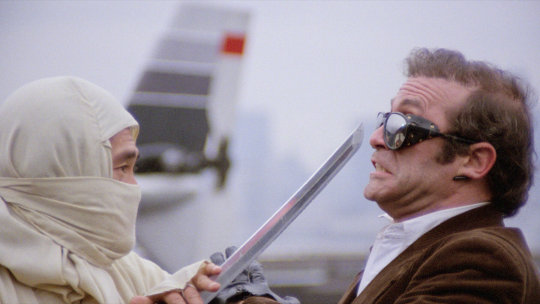
If you spend enough time (and money, mostly money, all hail capitalism) buying and watching things from different Blu-ray labels, you start to get a feel for the different sensibilities behind each one's curation of the films they release. And in that sense, New York Ninja feels so at home with the schlocky charms of Vinegar Syndrome's releases that if it didn't exist, they would will it into existence. Which is kind of what happened. A bunch of unreleased footage from an incomplete production of a ninja movie from the '80s was lovingly assembled into a finished film, with dialogue provided by a voice cast of genre stars (Don "the Dragon" Wilson, Linnea Quigley, Michael Berryman and others) and slapped with a snazzy new synth soundtrack courtesy of the band Voyag3r. What's even more surprising is the respect that went into this, and the overall coherence of the result. There's a certain goofiness inherent in the subject matter, but the movie doesn't play this up excessively, and the results feel true to the spirit of a real '80s ninja movie. And given that all the original audio elements were lost, the script wasn't available and the original director didn't want anything to do with the project, the story is actually easy enough to follow. It's a miracle this movie exists. As for whether it's any good...
Well, it feels like an authentic '80s ninja movie, and not an especially distinguished one, but if you like that kind of thing, it certainly has its charms. The original director and star is John Liu, a martial arts star best known for his superman kicking abilities, which Grady Hendrix claims, on the documentary included on the Blu-ray, were the result of extensive training and "perverted crotch torture" (a phrase both frightening and intriguing). One can see these abilities put to great use in the highly entertaining Invincible Armour, which contains one of the great villain deaths in cinema. These abilities can also be seen in New York Ninja, but in less potent a package.
Working with a minuscule crew inexperienced in shooting martial arts, the shot setups here are a lot more basic and the effect is more demonstrative than exciting. See John Liu kick the hell out of a bunch of goons who can barely keep up. (The goons here don't coordinate their outfits very well. At times it seems like the Ninja is fighting members of the Village People.) The effect is similar to Jackie Chan handily outperforming the much slower American stuntmen in Battle Creek Brawl. (I enjoy that movie enough, as director Robert Clouse understands Jackie's star qualities, even if he's not skilled enough to do them justice. And we get to hang out with Jackie's girlfriend Kristine DeBell.) But when the Ninja chases bad guys on rollerskates or does his big hair-raising stunt at the end, it's pretty hard to hold those shortcomings against it.
The other charms of the movie come from the "New York" part of the title. Pre-cleanup NYC is one of the ultimate movie settings if you're into genre fare, providing a reliable level of scuzzy texture to the proceedings. There's added sleaze thanks to the plot, which features the titular New York Ninja avenging the death of his wife by fighting a sex-trafficking ring run by the monstrous Plutonium Killer, who has a habit of murdering the girls his organization kidnaps with his radioactive hands. (I assume this is the sex-trafficking version of "getting high on your own supply", which seems like a poor business model.) The Ninja of course has a secret identity, and during his off hours attaches himself to a news crew determined to catch his exploits and build up his legend. He ends up with a dedicated fanbase, who bail him out with the cops at least once. There are even t-shirts, although it looks suspiciously like they just modified a bunch of "I ❤️ New York" shirts.
The movie settles into a pattern of the Plutonium Killer's goons terrorizing innocent women (including the great Sharon Mitchell, who gets harassed in the subway; alas, she has no dialogue) and the New York Ninja intervening to deliver justice. It's hard to say the movie really escalates, but the fun stuff comes steadily enough that I was entertained. And in case you're wondering, there's an end credits rap, for those of us who want to either relieve the glories of the preceding hour and a half, or didn't pay enough attention and need it summarized for us. I would suggest pairing this with Charles Ahearn's The Deadly Art of Survival, another movie that situates martial arts in pre-cleanup New York and features its share of ninja bullshit, although that one is surprisingly sincere about its belief that martial arts can better the community. (The star Nathan Ingram once received a medal from Ed Koch for foiling a bank robbery, so he seemed to practice what he preached.)
I chased this with a viewing of an earlier Liu directorial effort, Ninja in the Claws of the CIA AKA Made in China AKA Kung Fu Emmanuelle, a movie whose feverish incoherence makes New York Ninja seem downright classical in its storytelling. From what I could make out (and I confess some of the details escaped me), John Liu is hired by the CIA to train their operatives in martial arts (and of course, Liu had his own style, Zen Kwun Do) and then crosses them and escapes to Paris with his own secret heretofore unmentioned organization as the CIA tries to kill him. Also he has a twin brother (also played by Liu) who appears for one scene, disappears for 90% of the proceedings, and then *SPOILERS* is immediately machine-gunned to death when he makes his return. *END SPOILERS* There's definitely a Seagalian quality to the self-aggrandizing material, but the delivery feels like a direct transmission from the mind of a conspiracy nut who stayed up all night watching kung fu movies. How "good" this is I cannot say, but when Liu is fighting off a whiny little bitch played by Casanova Wong and ignoring a scantily clad female operative rubbing up against him at the same time, traditional standards of quality go out the window. (I assume that operative was the "Kung Fu Emmanuelle" of the alternate title. The version I watched trimmed out around twenty minutes from the runtime, which unless I hear other, will assume consisted entirely of more scenes of this character.) And of course, there are lots of great fights, the fruits of that frightening and intriguing "perverted crotch torture" that Grady Hendrix alluded to.
6 notes
·
View notes
Text
So, the reason I've been going through a bunch of Marvel Movies is kind of simple and stupid: I'm a weeb. An incurable, intractable weeb. And I've been absolutely certain that Japanese superheroes are better than American superheroes, despite having absolutely no point of comparison.
So if I'm going to claim that Japanese superheroes are better than American superheroes, I should at least be able to make some kind of comparison. Marvel is the biggest fish in the barrel, and along the way I'd like to see what all the Infinity War and Endgame hype was about.
And so far? Absolutely confirming my expectations. Japanese superheroes are, so far, just way better:
The masks that Japanese superheroes wear serve an important function: they let the stuntmen take center stage during action scenes. Every fight is fully choreographed and performed by experts. Marvel fight scenes fake nearly all of the action with CG and rapid cuts.
Japanese action scenes tend to be more "staccato" in a sense. Marvel fights are kind of an endless stream of events and rapid cuts, while Japanese action scenes revolve around a few key events, giving more weight and impact to each.
Those rapid cuts make it very hard to appreciate the craftsmanship in Marvel movies. Japanese superhero shows often linger on models and practical explosions, really bringing the labor and attention to detail into focus. Marvel movies seem almost ashamed of the fact that they are artificial and made by humans.
Japanese superheroes, for the most part, don't fall in love. When they do, they don't waste precious time on kissing. They know we're here for the punching, not the smooching.
1 note
·
View note
Text
American Movies Celebrating Guns

They say that you can tell a lot about a nation/culture by the kind of movies that come out of that country. Well, American movies are by and large full of guns and really stupid characters doing dumb things. Films and popular culture are a mirror held up to that nation. No wonder democracy is reputedly on its last legs in the US of A. The greater mass of American movies are dire tripe. The screenplays of many of them must have been written by 13 year old’s with foetal alcohol syndrome (with apologies to 13 YO’s). The plot, characterisation, and dialogue are so putrid that turning them off is the only option. American movies celebrating guns says a lot about the culture. Amazon, as a streaming service, must have the worst selection of American films I have witnessed in a long time.
Dumb and dumber must be their mission statement or cheap and cheaper perhaps.

Stop Watching American Movies With Guns In Them
I have a suggestion for every person who abhors the gun deaths and massacres occurring weekly in the US. Make a New Year’s resolution in 2024 to switch off every movie with a gun in it. Make a commitment to not support guns and gun violence by cancelling your participation in watching movies that celebrate guns. Hollywood is the biggest supporter of guns in America via their continual making of guns into stars in their product. Imagine if all right thinking citizens voted with their feet in terms of not watching films with guns in them. Pretty soon the producers and screen writers would have to change their movie making formulars to reflect what the public will watch.

Give Guns The Flick In 2024
Movies featuring guns that kill people are the stars of most American movies today. Actors pretending to be characters in a story pick up guns and shoot extras and stuntmen in movies. The human brain processes these things as pretty real and has visceral responses to the things it sees on the screen. Kids watching these movies get all excited and wound up by the violence portrayed on screen. Hollywood has been making these dumb films for decades. They call them action movies. The characters don’t think much in these films, they act with their guns in hand spraying bullets left, right and centre. Car chases and gun fight scenes are the bread and butter of action movies. Dumb sensory shit sending dumb messages about dumb behaviour. Killing someone with a gun is not a heroic act. Guns and bombs are really for cowards. It is using machines, devices, and technology to do your fighting for you.
Real courage uses no weapons. Real smarts utilises conflict management skills. Hollywood movies don’t celebrate these things. Their superficial concerns are all about entertainment via pyrotechnics and loud explosions. Movies and popular culture are mirrors, however, to the society they reflect.

America has no standards and they call this freedom.
What’s that quote? “Freedom’s just another word for nothing left to lose.”
The entertainment business in the US is awash with simulated violence and gun deaths. This is the mirror being held up to the American people. American movies celebrating guns are singing the death song of this once hopeful nation. Do yourself a favour and turn off the gun filled movies from your screens. Take a stand in 2024 and raise your own standards.
These dumb films are damaging your psyche and perpetuating the myth of guns as solutions to problems. Guns only make things worse. Guns and bombs are for cowards.
“In the wake of the mass shooting in Uvalde and far too many more, Hollywood veterans have circulated an open letter calling on Hollywood to be part of the solution, not the problem. The letter suggests being “mindful of on-screen gun violence and model gun safety best practices,” showing on-screen gun users locking guns correctly and making them inaccessible to children, limiting the ways they’re used on screen, and exploring alternatives.
The initiative was led by activists Robert Bowers Disney and Christy Callahan, who is co-chair for the advocacy group Brady United Against Gun Violence. Disney, the group’s national organizing director, told me that modeling good on-screen behavior around guns can have a much bigger impact than one might think and that social activists have had success with storytellers rethinking how they depict other social issues in the past.”
(https://www.vox.com/23180187/hollywood-good-guy-gun-movies)
Robert Sudha Hamilton is the author of Money Matters: Navigating Credit, Debt, and Financial Freedom.
©WordsForWeb
Read the full article
0 notes
Text
Rio Grande (1950)
A cavalry squad are positioned to fight off attacks from Native Americans but the senior officer has further troubles when his son is sent to his squad followed by his mother.
Much focus is given to the development of the son who isn’t even the protagonist. The progress he makes is the meeting of two parenting styles, authoritative and sensitive, converging into something healthier than both parents. There were some interesting stunts, particularly with the horses and the scenery was useful to maintain the aesthetic.
Quite a great deal of the scenes were slow paced and quiet, emphasising the repression of most characters’ feelings. This was contrasted by the loud, exclusively action scenes which were just chaos. There was the usual Western reductive view of history which makes war honourable and devolves any non-white culture into mindless enemies.
It’s interesting that John Wayne manages to be charismatic whilst also providing a fairly basic performance, largely helped by being the focus for most scenes. The only other attraction is the action scenes which appear large enough in scale and some risky stunt work falling from horses but it’s typical, one could almost paste the same “cowboys/Indians” fight into any Western and it’d have the same effect.
The romance wasn’t something to route for due to the history of abuse and destruction the couple have, her changing her mind about him had too many undertones of domestic violence. Any subtext got confused by the end since our alignment is forcing us to follow the path of invading settlers as though they’re the good guys.
3/10 -This one’s bad but it’s got some good in it, just there-
-The film was criticised for too much studio shooting and too many songs, the songs were defended on the grounds it was realistic for cavalry men to sing often.
-The film was mainly intended as a way to pay for the director’s next movie.
-Allegedly some of the stuntmen died when they fell from horses into a river from which they weren’t recovered.
0 notes
Text
idk how lyman dayton was able to get a rather stacked cast for last resort (1996)
stacked is relatively speaking but you got: dean stockwell, one of hollywood’s most prolific stuntmen, american sailor moon, angus bethune, mike nelson from twin peaks, selenas friend and mom, joey the rat, james caan’s son, that one dude from clueless, a guy from she’s all that, one of the guys from one world.
it’s a who’s who of random stars
0 notes
Link
0 notes
Text
picture this: you own a boat, you take tourists or locals on the boat to go along the beautiful bodies of water in Amsterdam. Today was just another average working day for you, a group of British dudes and one American showed up.
You hear them chatting calmly as you slowly motor the boat on it’s route, suddenly they started a commotion. It seems that two of them (the blond kid and the American) wanted to try dangling from the bridge ahead since it looked so “danglable” as they said, luckily one of the older in their group told them to cut it out.
You settled your nerves down since it looks they they’ve got it all under control and you probably won’t get into any trouble of drowning tourists any time soon.
The two loudly protesting had finally stopped, you can continue to do your job, and oh? What did the tall dude just said- OH FUCK SHIT HE JUST JUMPED ONTO THE PAVEMENT WHAT THE HECK- oh he came back on the boat, that was such a shock, wasn’t he the one in charged??! The reasonable adult???
Oh god he just hopes the kids won’t follow- THE PRICK DID IT AGAIN WHAT THE F U C K???!!!?!! Okay he’s back, oh gosh, your feeble heart. You looked to the oldest of them, a man in his thirties who was actually verbally generating your inner monologue out loud, there’s an understanding, sympathy it seems in his eyes, you two reached to an agreement, that these youngin’s all fucking lost it. Haa… they finally stopp-
OH GOD NOW ITS THE AMERICAN DUDE FUCKKKKKKKK ISTG IF HE FUCKING FALLS IN THE WATER- Oh well, he’s back in the boat, maybe it’s fine, they could handle themselves, you don’t earn enough to handle this shit.
Okay another bridge, you hoped, silently prayed in your mind for these unhinged bastards not to- I FUCKING KNEW IT THE AMERICAN OH GOD, on the other hand it’s pretty funny for the rest of the group to panic as the boat goes pass the bridge leaving their friend dangling mid-air, over water, under the bridge. Okay ngl, it’s quite impressive how long the dude lasted on the bridge until you turned the boat (the boat’s actually slow asf so props to the dude fr, what a chad).
You’re also really impressed with how the loudest and who he thought would be the first to partake in these risky activities, the blond kid’s just sat at the boat as the other two stuntmen taunt him into pulling those same stunts. Good lad, they all settled into comfortable silence, you yourself also relaxes a bit, let’s hope this trip have a calming end…..
The kid- the kid- FUCKING TARZAN-ED ON THE WILLOW BRANCH WHAT THE ACTUAL FUCK HE NEARLY FELL IN THE WATER- welp he hit your sympathizer instead.. okay that was better than the water and it’s pretty funny too, sorry (a look of betrayal the man sent you as you try to stifle a laugh from the scene, it was just too funny they can’t blame you).
You send them off, wasn’t too bad of a group, they even tipped you for your services (also for the permanent mental scars but oh well), they were pretty nice after all (you prayed to never meet them again).
Tubbo&Phil the entire time: *sat there judging* grown ass men grown ass men 🙄🙄
#short fic#inspired by tommy’s amsterdam story on stream#stream: does anyone still see this notification? Say hi if yes#tommyinnit fics#philza minecraft#wilbur soot#charlie slimecicle#tubbo#tommyinnit#boat crew
27 notes
·
View notes
Text
The World’s Greatest Stuntman Skull
[Plain text: “The World’s Greatest Stuntman Skull” in medium text. /End PT]
We all know Skull was not only a stuntman prior to become an Arcobaleno/get involved in the mafia, but the stuntman too.
And sometimes I find myself wanting to include it in my fics, but realize I actually don’t have the single clue what it’s all about lol.
So I did some researches on it.
[Plain text: “We all know Skull was not only a stuntman prior to become an Arcobaleno/get involved in the mafia, but the stuntman.
And sometimes I find myself wanting to include it in my fics, but realize I actually don’t have the single clue what it’s all about lol.
So I did some researches on it” in medium text. /End PT]
*
Stunt Performers | Overview
[Plain text: “Stunt performers | Overview” in medium and bold text. /End PT]
Stunt performers, otherwise known as stuntman or stuntwoman, are trained professionals who performs daring acts, otherwise known as stunts, often as their career.
They appear in movies or television, as opposed to daredevils who performs stunts for the sake of stunts in front of a live audience.
When they take the place of another actor, they are known as stunt doubles.
Despite the various means in place to reduce the risk of injury or death, the stunts remain very dangerous and physically testing exercises.
From its inception as a professional skill in the early 1900s to the 1960s, they were most often performed by professionals who had trained in that discipline prior to entering the movie industry.
Current film and television stunt performers must be trained in a variety of disciplines, and must be a certified trained member of a professional stunt performers organization first in order to obtain the necessary insurance to perform on the stage or screen.
However, even when executed perfectly, there is still strain, and performing stunts often results in unplanned injury to the body.
*
Stunt Performers | History
[Plain text: “Stunt performers | History” in medium and bold text. /End PT]
The earliest stunt performers were traveling entertainers and circus performers, particularly trained gymnasts and acrobats.
They were known as cascadeur, from the French word “cascadeur”, which may have been derived from the requirement to fall in a sequence of movements during a scene or stunt involving water.
Later, the German and Dutch circus used the word Kaskadeur, which meant performing a sequential series of daring leaps and jumps without injury to the performer. This acrobatic discipline required long training in the ring and perfect body control to present a sensational performance to the public.
The word “stunt” was more formally adopted during the 19th-century traveling vaudeville performances of the early Wild West shows, in North America and Europe.
------
By the early 1900s, the motion picture industry was starting to fire-up on both sides of the Atlantic Ocean, but had no need for professional stunt performers.
For one, because there were more than enough applicants willing to do the scene for free and for real (I wonder why lol?).
Two, the Spanish–American War had just ended, and there were many young men who were physically fit and trained in the handling of firearms looking for some work.
Thirdly, the former wild west was now not only tamed, but also starting to be fenced in, greatly reducing the need for and pay of the former cowboys.
------
As the industry developed in the West Coast around Hollywood, California, the first accepted professional stuntmen were clowns and comedians, as the staple diet of the early films was an almost continual roll call of pratfalls, high dives and comedy car wrecks—the basic ingredients of a circus clown’s routine.
But much like their circus-based predecessors, these actors/stuntmen were not specifically trained to perform stunts, but instead learned through trial and error.
------
From 1910 onward, the mostly western-themed scripts required a lot of extras, such as for a galloping cavalry, a band of Indians or a fast-riding sheriff’s posse.
The directors turned to the current rodeo stars for inspiration for their action scenes, and employed former cowboys as extras who not only brought with themselves the right look and style, but also rodeo techniques that included safe and replicable horse falls.
Thus, stuntmen were now an integral part of a film's drawing power, helping to fill cinemas with thrill seeking patrons anxious to see the new Saturday matinee.
------
The preference to employ ready existing professionals from outside the film industry, either as performers or doubles, continued in the period both up to and beyond World War II, when again the industry was awash with young, fit men looking for work.
Though with the introduction of car chases stunts in 1958 (and the subsequent rise in accident rate), the stunt performers took action to professionalize their industry, with the creation of new stunt performer run registration, training, certification, and booking agencies.
Around that time modern stunt technology was also developed, and the co-development of this technology and professional performance training provided a safe platform to a new breed of trained professional stunt performers, and motorcycle greats.
These new professionals were not only driven to create visual impact, but also perform seemingly impossible feats in a safe and repeatable way.
(Source)
*
Some More Specific Terms |
[Plain text: “Some more specific terms” in medium and bold text. /End PT]
Stunts |
[Plain text: “Stunts” in bold text. /End PT]
A stunt is an unusual and difficult physical feat or an act requiring a special skill, performed for artistic purposes usually on television, theaters, or cinema.
Before the use of computer-generated effects (CGI), they were limited to the use of various camera effects, unless someone was willing to perform them for real, i.e, the stunt performer or stunt double.
There’re different types of stunt effects: practical, mechanical, vehicular, and CGI.
Practical effects are the physical ones (typically jumps or falls), or the ones which require contact between the performers, though it’s normally avoided.
These types of performances are highly choreographed and may be rigorously rehearsed for hours, days and sometimes weeks before a performance.
Stage combat is the most frequently used practical stunts, but other examples of practical effects include tripping and falling down, high jumps, extreme sporting moves, acrobatics and high diving, spins, gainer falls, “suicide back flips,” and other martial arts stunts.
Mechanical effects are the ones performed with the help of mechanics. Namely, the use of special harness, or wires and rigging, for risky/high jump, or “fly” sequence, or movies that use kung-fu.
Vehicular stunts are the ones performed with vehicles, and sometimes specially adapted ones. They can be as simple as a handbrake turn, or as advanced as car chases, jumps and crashes involving dozens of vehicles.
CGI effects appears in the late 20th century when filmmakers turned to relatively inexpensive (and much safer) computer graphics effects using harnesses, fans, blue or green screens, and a huge array of other devices and digital effects. Thus stunt performers were placed in less and less dangerous situation.
But even if stunt work has increasingly been made safer and enhanced by CGI effects, stunt performers remain essential to provide a human quality to the action.
(Source)
------
Stunt doubles |
[Plain text: “Stunt doubles” in bold text. /End PT]
Stunt double is a cross between a body double (a person who substitutes in a scene for another actor such that the person’s face is not shown) and a stunt performer.
They’re used specifically for a dangerous skill replacement, such as jumping out of a building or from vehicle to vehicle, and for other sophisticated stunts (especially fight scenes).
A dance double is a type of stunt double who steps in and performs the dangerous or physically difficult dance parts of a character’s role in film or television.
Stunt doubles like stunt performers should be distinguished from daredevils, who perform stunts for the sake of the stunt alone, often as a career.
Many stunt doubles have long production careers as part of a star actor’s contractual “support crew”, though some actors are known to have performed their own stunts, and others started as stunt doubles.
Stunt doubles have to look like their respective actors if at all possible, in order to maintain the illusion that it is the actor on-screen.
They’re also used when the actor doesn’t legally hold the required class of license.
(Source)
------
Daredevils |
[Plain text: “Daredevils” in bold text. /End PT]
Daredevils, unlike stunt performers and stunt doubles, performs stunts for the stunt itself, without the context of a film or television show, and often for an audience.
These live stunts include escape artists, sword swallowers, glass walkers, fire-eaters, trapeze artists, and many other sideshow and circus arts.
They also include motorcycle display teams and the once popular Wall of Death.
Some people act as both stunt performers and daredevils at various parts of their career.
(Source)
------
Stunt Coordinators |
[Plain text: “Stunt coordinators” in bold text. /End PT]
A stunt coordinator, usually an experienced stunt performer, is hired by a TV, film or theater director or production company for stunt casting.
The stunt coordinator will arrange the casting and performance of the stunt, working closely with the director.
In many cases, the stunt coordinator budgets, designs and choreographs the stunt sequence to suit the script and the director’s vision.
It’s his responsibility to create an environment where open dialogue among cast & crew involved in stunts can occur, and to ensure that adequate rehearsals and planning occur prior to filming on set, and also ensure that performer credentials are vetted.
(Source)
*
Stunt Performers | Credentials
[Plain text: “Stunt performers | Credentials” in medium and bold text. /End PT]
No specific certification or degree is required to become a stunt performer, though stunt schools, as in ones who’d give you a stunt degree that’d allow you to land a job aren’t a thing anyway.
This means that aspiring stunt professionals need to piece together their own education in the field.
------
The first step towards a career as a stunt double is to develop the skills to do the job.
Most stunt performers recommend covering the basics with classes in stage combat, gymnastics and martial arts, though some recommend specializing to help stand out, but whether you specialize or generalize, the list of potential skills to develop is long.
Stunt performers generally need to possess skills in the following areas: fighting (martial arts, boxing, or swordplay), falling from heights, riding and driving (including motor vehicles and horses), swimming and scuba-diving, and agility and strength.
It’s useful to have a diverse range of skills, and beneficial to have a diversified background in various (physical) activities.
In that respect, enrolling in a training program or stunt school could be useful.
------
Stunt performers often do attend stunt school. They often last around a month and can be quite costly.
Precision driving skills, wire work, martial arts, high falls, rappels, stair falls, foot falls, harness work, weaponry, and unarmed combat are a few of the things you’ll learn at a school like the International Stunt School.
Stunt training academies offer seminars and courses on how to perform various stunts, and would give you some good field experience.
Even if you feel confident in your abilities, a program can help you diversify your stunt resume, perfect a certain skill, and learn relevant industry lingo.
Though again, it’s important to note that while these programs provide safe and professional stunt training, they cannot guarantee you a job and are not required in the industry.
Generally speaking the most important skills required are physical fitness, stamina, strength and coordination. A class in stage combat is also a must.
------
Another way to acquire experience is getting employment as an apprentice to an established stuntman, as hands-on experience is priceless.
It’s the case of a lot of stunt performers who learn their craft through a long apprenticeship with an experienced stunt person. But here again, there’s no clear way to get such an apprenticeship; no formal method of approaching it.
And though no formal education is required to work as a stuntman, to apply for a job you must be a member of your country stunt performers union/organization. (As I understand it anyway, it was confusing.)
Lastly, as a career dependent upon your physical abilities, it’s crucial to train routinely, stay healthy, and work to perfect your skills.
And because age may be a prohibition to entering or continuing stunt work; most performers are between the ages of 20 and 40.
*
Stunt Performers | Career
[Plain text: “Stunt performers | Career” in medium and bold text. /End PT]
Resume |
[Plain text: “Resume” in bold text. /End PT]
An 8-x-10-inch headshot is a must, and should look polished and clearly show your face and body type even if not taken by a professional (which isn’t required).
Your resume should include relevant training courses you’ve taken, a list of your abilities and, if necessary, descriptions of your skill level within each of them, physical measurements including height, weight and shoe size, any film, TV or live performance credits and any union affiliations.
Directors and producers use these materials not only to discern your skills but to evaluate whether you’de be appropriate for a certain scene or for doubling for another actor, so it’s important to show off what you look like as much as what you can do.
Listing a stunt training school on your resume may draw attention within the industry and help you get an interview.
Putting together a stunt demo video of yourself performing several stunts that demonstrates your abilities to as many professional stunt coordinators as possible is highly recommended.
------
Landing a Job |
[Plain text: “Landing a job” in bold text. /End PT]
Landing a job is done mostly through determination and self-marketing.
One way to break into the industry is as a background performer, also known as an extra.
To get started as an extra, submit a photograph and resume to whatever agency that specializes in background actors.
As an extra, you’ll get the opportunity to be on set, accumulate credits for your resume, and receive vouchers that you can use to join a union.
Make also sure to list your special skills on your resume as it could lead to performing stunts as a background actor.
This would put you in touch with the onset stunt coordinator who could be in a position to get you your first union job somewhere down the line.
Three full days of working as a background actor will also qualify you for entry into the union.
While working as an extra, your relevant skills may convince a stunt coordinator to hire you as a Special Ability Extra.
This upgrade allows you to begin building a relationship with a stunt coordinator, who may hire you for your first real stunt.
------
Once a stunt performer has a foot in the door, they will gradually work their way up until they finally get to work on a big stunt.
But even at this level the work isn’t steady and there’s a lot of competition for just a few jobs.
And very rarely will a stunt person get a contract to perform stunts regularly over a long term.
------
Networking |
[Plain text: “Networking” in bold text. /End PT]
Stunt work in Hollywood is family business. Many working stuntmen and women have parents and even grandparents who worked in the industry.
Performing as an extra, or background actor, is often the best way to get on a film set and make the necessary contacts that will lead to stunt work.
Also, knowing anyone in the film industry that can lead you in the right direction or introduce you to the right people would definitely help.
Continually building your credits and professional relationships are crucial throughout a career as a stunt performer.
Like any industry it’s who you know, but in the stuntman industry, it can also be about what you look like, what skills you have, and where you are.
------
Other Positions |
[Plain text: “Other positions” in bold text. /End PT]
Stunt coordinators, as we already talked about above, who lead the stunt department for a film, creating action scenes by designing stunts, hiring crews, overseeing performances and more.
Stunt riggers who handle the mechanical requirements for stunts, setting up equipment and ensuring safety precautions are followed.
Second unit directors who often handle filming action sequences independent of the main or “first” unit, which usually films principal actors, and can be similar to or the same as stunt coordinators.
------
Conditions |
[Plain text: “Conditions” in bold text. /End PT]
Stunt performers work wherever the movie or television show is being filmed.
They may have to work from 4 AM to 11 PM and then get up at four again the next morning.
The work is done in all types of weather, most likely outside, and involve traveling around the world and can take them away from home for extended periods of time.
Stuntmen average $70,000 per year. If you’re newer to the industry, you may only make $5,000 per year.
Though it all depends on how much work you manage to find, the highest end stuntmen can make up to $250,000 per year.
All it takes is one stunt to make money.
(Source), (Source), (Source), (Source), (Source)
*
Tl;Dr |
[Plain text: “Tl;Dr” in medium and bold text. /End PT]
Skull is literally so skilled guys?? He is a highly trained professional, physically very strong, with various skills that definitely can come in handy when you suddenly find yourself being part of the mafia.
He’s SKILLED, and TALENTED, and RESOURCEFUL, and INDEPENDENT, and totally would know how to hold his ground in a fight (mafia or not).
He is an Arco through and through (I will die on this fucking hill), thank you for coming to my TED talk.
[Plain text: “Skull is literally so skilled guys?? He is a highly trained professional, physically very strong, with various skills that definitely can come in handy when you suddenly find yourself being part of the mafia.
He’s SKILLED, and TALENTED, and RESOURCEFUL, and INDEPENDENT, and totally would know how to hold his ground in a fight (mafia or not).
He is an Arco through and through (I will die on this fucking hill), thank you for coming to my TED talk” in medium text. /End PT]
*
Thank you for reading! And feel free to add and/or correct me if I got anything wrong.
Also let me know if you would be interested in a similar post about circus?
#katekyo hitman reborn#khr#khr meta#khr skull#stuntman#stuntmen#stuntman work#arco backgrounds series#khr ref#please do appreciate this post#it took time to put together asdfgh#also at times i mostly did copy paste#i sure hope it's allowed??#if not let me know so i can cancel this whole post lmaoo#mine
103 notes
·
View notes
Text
“Who are you?” The scene that defines Chadwick Boseman’s legacy

Yesterday, the world lost a bright and promising, burgeoning talent in Chadwick Boseman.
I had wondered privately for a while if something was wrong with him, as others had as well online, as he appeared increasingly sicker with each interview he gave over the last two years. I thought maybe I had been looking too much into it, not wanting to jump to conclusions about who he was but now gravely we all know why.
The much too young star of films such as “42,” “Marshall,” and of course, “Black Panther” had been fighting a largely private battle with colon cancer for four years.

It was devastating hearing this news yesterday, the man who undeniably left behind a legacy of playing prominent black heroes, both historical and fictional, passed away just as he was starting to truly hit it big. When you begin to realize the man was dealing with cancer as he performed physically demanding roles in the MCU you begin to see the character and determination of a man unwilling to quit in the face of true adversity.
But he clearly wasn’t just doing it for himself when he continued making and promoting NINE more movies despite his diagnosis, afterall no one would’ve blamed the guy for taking it easy these past four years. He’s had many scenes that define his legacy over his all too short career but I feel it can really be summed up in one particular moment from by far his most famous film; “Black Panther.”
Those who know me or have read my work know that I have a fairly cynical relationship with the Marvel Cinematic Universe. While I would not say most of them are “bad” per se, I would say a ton of them are largely interchangeable action comedies with pretty straightforward messages about good vs evil for general audiences. They are largely popcorn escapism and though there is nothing technically wrong with that, I was starved for an MCU film that was sincere about its story finally and had something real to say.
Enter “Black Panther” in early 2018.
youtube
“Black Panther” was everything I had long been waiting for in the MCU; a film with a real sense of vision and theme, a killer soundtrack, great supporting characters, a complicated and nuanced villain, and a story that didn’t feel the need to add a joke after every single scene like more typical MCU movies. The tip of that spear of course was Chadwick, who had already proved to be a great Black Panther in one of the few other sincere Marvel flicks “Civil War.” His natural charisma, physicality, and dramatic presence in this role made him a huge standout in frankly the best ensemble cast of any superhero movie ever.
The scene that truly sums up not just the mark “Black Panther” left on Hollywood but Chadwick’s own legacy comes at the very end though (the first of three, of course. It’s an MCU movie, afterall).
T’Challa has defeated his usurper cousin Erik Killmonger, his rule restored in Wakanda but clearly a changed man from the story’s beginning as he reckons with the complicated legacy of his father. He travels to Oakland, the birthplace of Killmonger, with his sister Shuri who he explains the crime committed by their father in this place and how it set off the events of the story. He turns to Shuri, tells her that he has decided to help this afflicted community by creating a Wakandan outreach center for the youth to give them a new hope in life. As he says this he decloaks their ship nearby, surprising the youth already in the area who are immediately in awe of it. One of the kids turns to T’Challa, smiling, a sense of inspiration and intrigue brewing inside, and asks “Who are you?” to which the young King simply smiles, then the credits roll.
youtube
It’s a simple scene but it truly speaks to the impact left behind by Chadwick and the importance of representation.
“Black Panther” is hardly the first starring vehicle for a black man, it’s not even the first black super hero movie but what it made it different is it was the first blockbuster to truly lean unapologetically into its African identity to focus on the inspiration of a story centered around that culture. It showed Hollywood that an action blockbuster not just centered on a black star but centered on African culture had vast widespread appeal.
White kids will never have a shortage of white superheroes to grow up with on the big screen; a diverse palette of Supermans, Spider-mans, Captain Americas, and shit we’re even getting our sixth new Batman actor since 1989 soon. But Chadwick gave black kids their first real Superman of their own.
In the years since this came out, I have seen the influence, at times, firsthand among the youth. I work part-time as a kids martial arts instructor and each Halloween party we’ve held I’ve seen a few more T’Challas among the costumes represented. When I ask kids, black, white, or Asian, what their favorite superhero is, it always warms my heart to see a kid light up when they say “BLACK PANTHER!”
youtube
(Seriously, cute AF)
This goes beyond just my anecdotal observations of course; the film grossed a billion dollars, and there are countless videos online of kids yelling “Wakanda forever!” at the top of their lungs while rocking a Black Panther suit or reciting one of the movie’s memorable lines. It’s beautiful because it speaks to that last scene’s key message; inspiration.
Growing up myself, as a half Asian American, there weren’t a ton of role models who looked like me to take inspiration from. I didn’t really understand how much this could affect me until I finally did start seeing people like myself occupy positions of influence. I didn’t start caring for baseball until I saw a slugger named Hideki Matsui smash a couple dingers in a Yankees’ uniform in the early 2000s. I didn’t care much for martial arts, outside my very early youth, until I witnessed a half Japanese Brazilian named Lyoto Machida KO Thiago Silva at UFC 94 in 2009. I didn’t care much for soccer until a striker named Keisuke Honda played out of his mind in the early rounds of the 2010 FIFA World Cup.
Sometimes you gotta see something happen in order to believe and be inspired by it and it’s easier to visualize it when you see someone who looks like you do it. That’s what representation means and why it’s important.
It’s easy for white America to dismiss the need for representation in media when theirs is so saturated in the culture everyday. Cries of “wHaT aBoUt wHiTe HiStORy mOnTH?!” delivered unironically while their history is proudly given front seat consideration in all forms of media, film, and influence every day. This is why it drives me so crazy when a white person tells me “representation isn’t important” because apparently, they “don’t need it.”
Well motherfucker, of course you don’t need it. You fucking got yours already!
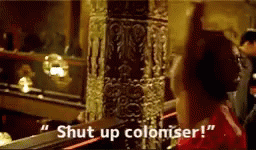
(What every non-white person wants to say when confronted with this tired, out of touch argument...)
“Black Panther” delivered a superhero that not only black children could be proud of and love but someone they could draw inspiration from. Kids are going to want to become film directors cause of this movie, actors, stuntmen, martial artists, scientists, engineers, and so many other different things that the world of Wakanda proudly showcases and it’s all thanks to Chadwick’s leading man performance that made it possible.
Some jokes I’ve heard frequently on the internet is that Chadwick was on somewhat of a quest to play every major black role in story-telling history, what with performances as Jackie Robinson, Thurgood Marshall, James Brown, and of course Black Panther. But I think his 2018 speech at his Alma Mater of Howard really explains why he kept looking to play these major positive black roles.
youtube
(I encourage you to listen to the whole thing but the part that’s important here begins at 21:55)
Hollywood likes to pigeon hole certain demographics of people (aka non-white) to play stereotypical roles forever until they are proven to be lucrative in different ways (Qualified Immunity of film-making if you will…). Black people largely could mostly play thugs and drug dealers, Latinx can only be gang bosses and poor servants and gardeners, Asians are either kung fu masters or some other offensive perpetual foreigner. And in worst cases no role at all, instead whitewashed for general audiences (aka white folk).
Chadwick took a stand that the color of his skin did not define who Hollywood narrowly believed he could perform as and set out to play characters and people who could inspire a new generation of African Americans and show the rest of the country that they were more than a stereotype.
When that young kid in that final scene asks, “Who are you?” and T’Challa smiles its because he knows he’s already changing hearts and minds for the future, just as Chadwick did playing this truly inspirational role.

“Black Panther” is not a perfect movie. I could discuss the ways it could’ve been better and even, less problematic in parts on a different day, but the legacy it leaves behind is one that’s undeniably positive and Chadwick was able to make that a reality. Perhaps he understood that if the world knew his diagnosis it would blunt the impact of “Black Panther’s” release, that if little kids and African Americans alike knew their superhero was already dying it would mar the film’s positivity and influence. I can’t speak for the dead obviously, and in no way am I saying one should just push through a cancer diagnosis and keep it secret, but I can see Chadwick understanding what it would mean for the audience if they just believed for as long as possible that they would have their king of Wakanda forever.
As Robert Downey Jr. said on social media last night “He leveled the playing field while fighting for his life.”
Though I will never know him personally, by most measures Chadwick seemed to be exactly the kind of hero he showed up to be on the big screen and his legacy will ultimately be that of one who looked to inspire others, particularly the next generation until his final breath. If that doesn’t make him a hero, I don’t know what does.
Rest in power, King. Wakanda Forever…
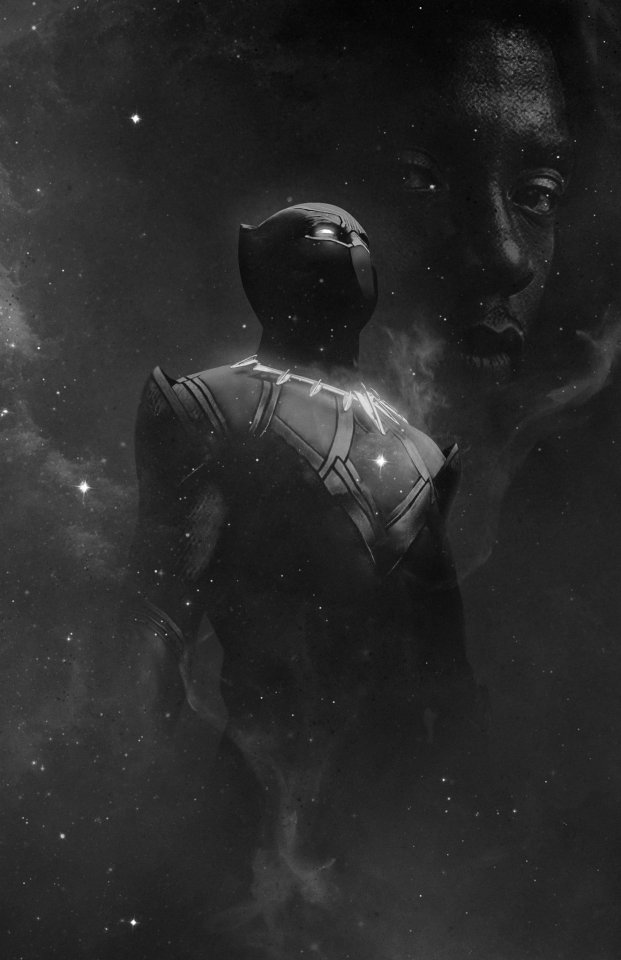
(Via BossLogic)
#Chadwick Boseman#rest in power chadwick#eulogy#Black Panther#Ryan Coogler#MCU#Marvel Comics#Marvel#marvel cinematic universe#Stan Lee#comics#super heroes#superman#batman#spider-man#miles morales#Spiderverse#t'challa#jackie robinson#black history#blm#black lives matter#ancestral plane#movie#tv#film#howard university#legacy#black representation
110 notes
·
View notes